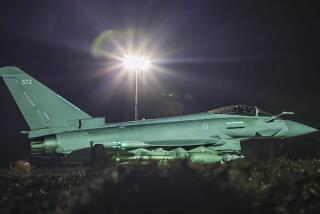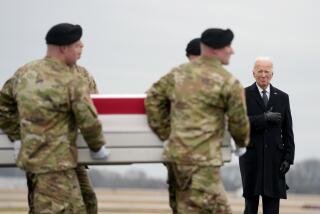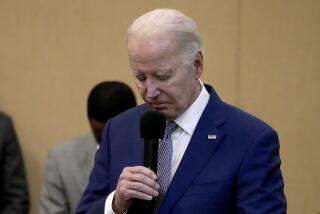U.S. Jets Intercept Iraqi Warplane Over Kurdish Territory : Gulf force: Fighter is spotted just inside âno-flyâ zone and turns back immediately. Pentagon says it was first violation since April and may have been inadvertent.
WASHINGTON â Two American fighter jets intercepted an Iraqi warplane that crossed into the âno-flyâ zone over Kurdish areas of northern Iraq on Thursday, the first such intrusion in five months.
The Iraqi jetâs flight over the northern exclusion zone, which was established by the victorious allies after the Persian Gulf War, does not appear to have been deliberate, Pentagon officials said, and the plane turned back immediately.
But the Bush Administration used the occasion to warn Iraq against testing allied resolve to enforce the flying restrictions.
âItâs a technical violation of the no-fly zone,â Defense Department spokesman Pete Williams said. âWhether it was advertent or inadvertent doesnât matter.â
The incident came as Washington and its allies ordered cutbacks in the pace of flights over southern Iraq.
Two weeks ago, U.S., French and British warplanes began aggressive patrols over southern Iraq to enforce a new no-fly zone established to protect dissident Iraqi Shiite Muslims living there.
âWhen the operation first started, during those first couple of days, we flew very aggressively to show our seriousness, demonstrate the coalition resolve and delineate fully the entire area of southern Iraqâ south of the 32nd Parallel, Williams said. âWe have, in fact, been able to scale back the intensity of the flights a little bit,â he added, because Iraq âhas abided by the rules.â
Thursdayâs incident, however, occurred over northern Iraq, where the allied powers have barred Iraqi aircraft since the end of the Gulf War. That zone, lying north of the 36th Parallel, was established to protect dissident Iraqi Kurds against retaliation.
Iraq has publicly chafed over the flying restrictions, calling them a violation of Iraqi sovereignty by the allies. But Iraqi aircraft have rarely ventured into no-fly zones.
The last previous such crossing occurred in April, when Baghdad scrambled its planes to respond to an Iranian air raid on targets in Iraq.
Williams said that two U.S. F-16 fighters based at Incirlik Air Base in Turkey were flying over northern Iraq on Thursday morning when an AWACS surveillance plane detected the Iraqi jet flying northward across the 36th Parallel.
The U.S. warplanes approached the Iraqi plane close enough to identify it as a French-made F-1 Mirage aircraft and noted that the Iraqi jet already had turned and was heading south again.
The Iraqi plane penetrated the exclusion zone by roughly three miles before turning back, Williams said.
At the planeâs normal operating speed, such a distance would take just over 10 seconds to cover, and Pentagon officials said the planeâs pilot may not have known he had crossed over the line.
The Iraqi pilot did not make any hostile gesture against the Americans and did not turn on his weapons radar, Williams said.
Such a move would have readied missiles for use and American interceptors would likely have been interpreted as a threatening act.
The two U.S. Air Force pilots could not tell whether the Iraqi plane was armed, Williams said.
More to Read
Sign up for Essential California
The most important California stories and recommendations in your inbox every morning.
You may occasionally receive promotional content from the Los Angeles Times.











